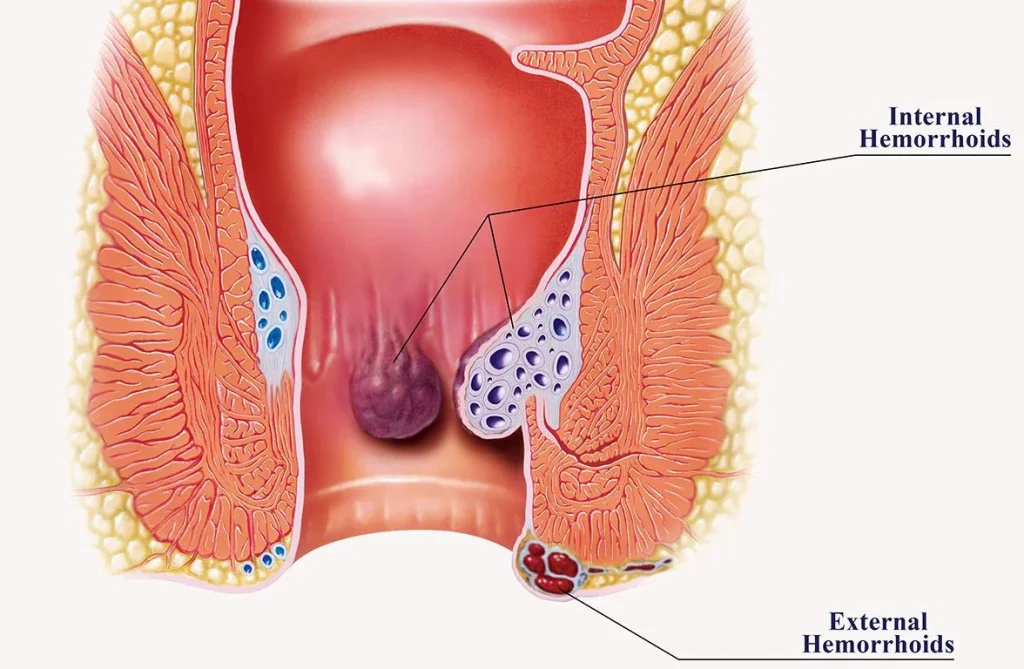Hemorrhoid disease, also known as piles, has become one of the most common anal diseases worldwide.
It is divided into two groups as internal and external hemorrhoids and is also classified into stages.
It is frequently observed in individuals who have a habit of straining during bowel movements, especially in cases of constipation. Hemorrhoid treatment can range from simple preventive measures based on the severity of the disease to surgical interventions in a clinical or hospital setting.

What is Hemorrhoid?
It is a condition that occurs as a result of the expansion and inflammation of the veins (cushions) around or inside the anus. Normally, these veins can expand and contract during bowel movements. However, in some cases, these veins can continuously expand, leading to the formation of hemorrhoids. (1)
What Causes Hemorrhoids?
Constipation or diarrhea: Prolonged constipation or frequent diarrhea can affect the bowel movement process and contribute to the formation of hemorrhoids.
Excessive straining: Excessive straining during bowel movements can strain the veins in the anal region, contributing to the development of hemorrhoids.
Age: With age, veins may lose elasticity, increasing the risk of hemorrhoid formation.
Pregnancy: Pregnancy can encourage the formation of hemorrhoids due to the pressure of the growing uterus on the anal region.
Genetic factors: Individuals with a family history of hemorrhoids may be predisposed to this condition.
What are the Symptoms of Hemorrhoids?
Pain or discomfort: Associated with a feeling of pain or discomfort in the anal region. There may be an increased sensation of pain when sitting or during bowel movements.
Itching: Itching in the anal region can be associated with inflamed hemorrhoids. It is often accompanied by a sensation of dampness. (2)
Bleeding: One of the most common symptoms is bleeding. Bloodstains may be seen on toilet paper, in the stool, or in the toilet. Bleeding is usually bright red.
Straining During Bowel Movements: Can lead to straining during bowel movements, which may contribute to constipation or other bowel movement problems.
Small Soft Lumps with Stool: Can cause the formation of soft, swollen lumps in the anal region. These small lumps may be noticed during bowel movements.
What Helps with Hemorrhoids?
Consume Fibrous Foods: Foods rich in fiber can soften the stool, prevent constipation, and alleviate hemorrhoid symptoms. Whole grains, vegetables, fruits, and legumes are good sources of fiber.
Drink Plenty of Water: Adequate water intake can help soften the stool and prevent constipation. It is recommended to drink at least 8 glasses of water a day.
Prevent Constipation: Constipation can worsen hemorrhoid symptoms. Fiber-rich foods, sufficient water intake, and regular exercise can help prevent constipation.
Cold Packs: Applying a cold compress to the anal region can reduce swelling and alleviate pain. However, avoid placing the cold pack directly on the skin; use a cloth as a barrier.
Sitz Baths: Sitz baths can help clean and relax the anal region. You can use a bath with warm water or fill a sitz bath basin and sit in it.
Topical Creams and Lotions: Over-the-counter hemorrhoid creams and lotions can help alleviate itching and discomfort. However, it is important to consult a healthcare professional before using these products for an extended period.
Exercise: Regular exercise can improve circulation and support bowel movements. However, avoid overly strenuous exercises.
Which Doctor/Specialist to Consult for Hemorrhoids?
You should consult a general surgeon. However, it is important to note that you should preferably choose a surgeon specialized in proctology.
Proctologist: Proctologists are specialists who deal with the anus and rectum. Since hemorrhoids typically occur in this area, proctologists are experienced doctors in the treatment of hemorrhoids.
Gastroenterologist: Gastroenterologists focus on digestive system issues. As hemorrhoids are often related to the digestive system, gastroenterologists can also assist in hemorrhoid treatment.
How is Hemorrhoid Treatment Performed?
Rubber Band Ligation:
The doctor can apply a rubber band around the hemorrhoid to block blood flow. This may cause the hemorrhoid to shrink and fall off. (3)
THD Procedure:
THD stands for “Transanal Hemorrhoidal Dearterialization,” a treatment method performed using Doppler ultrasound. Doppler ultrasound helps visualize and treat the expanded veins in the anal region by identifying them. After identifying the expanded veins using Doppler ultrasound guidance, the doctor reaches the tissues around these veins with stitches or a special ring, causing the vein to contract. This reduces blood flow in the vein and may contribute to the shrinkage of the hemorrhoid.
THD is considered a less painful procedure compared to traditional surgical interventions. Patients often experience a faster recovery and require less hospitalization.
Surgical Intervention:
In cases of severe hemorrhoids or when other treatments are not effective, surgical options may be considered.
Hemorrhoidectomy: Surgical removal of hemorrhoids.
Stapled Hemorrhoidectomy (Longo Procedure): A surgical procedure involving the rearrangement of tissues inside the anus.
Does Hemorrhoid Cream Treat?
Hemorrhoid creams generally contain the following types of ingredients:
Corticosteroids: Used to reduce itching, pain, and inflammation. However, long-term use is not recommended due to potential side effects.
Anesthetics: Used to relieve pain.
Vasoconstrictors: Vasoconstrictors, which constrict blood vessels, can be used to reduce swelling. However, prolonged use of these substances can damage the skin.
Combination Medications: Creams containing multiple active ingredients are also available.
REFERENCE
- Lohsiriwat, V. (2015). Treatment of hemorrhoids: A coloproctologist’s view. World Journal of Gastroenterology: WJG, 21(31), 9245.
- Sneider, E. B., & Maykel, J. A. (2010). Diagnosis and management of symptomatic hemorrhoids. Surgical Clinics, 90(1), 17-32.
- Lohsiriwat, V. (2012). Hemorrhoids: from basic pathophysiology to clinical management. World journal of gastroenterology: WJG, 18(17), 2009.